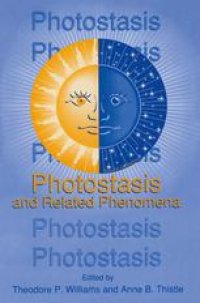
Ebook: Photostasis and Related Phenomena
- Tags: Ophthalmology, Pharmacology/Toxicology, Animal Anatomy / Morphology / Histology
- Year: 1998
- Publisher: Springer US
- Edition: 1
- Language: English
- pdf
Over the weekend of 21-23 February 1997, a small group gathered in Tallahassee, Florida, at the invitation of Ted Williams, to discuss "photo stasis and related topics." The majority of participants were former students and colleagues of Ted's, but an occasional outsider such as myself was generously included. The papers presented there are collected in this volume. The theory of photo stasis was first outlined in a landmark paper by John Penn and Ted, published in 1986 in Experimental Eye Research. They provided compelling data showing that, in the albino rat eye, levels of rhodopsin, outer-segment length, rhodopsin regeneration rate, and even, perhaps, rhodopsin packing density all depend on the levels of cyclic illumination (12 hours light, 12 hours dark) in which the animal was reared. So, for example, there is fourfold less rhodopsin in a retinal extract derived from an animal reared at 400 lux than in an extract from the retina of an animal reared at 3 lux. Animals reared at intermediate levels of light show intermediate amounts of rhodopsin that are correlated with illumination level. What these data immediately suggested is that the photoreceptor cell can adjust its photon-catching ability in response to the levels of light in which an animal is reared, and they also provided a compelling rationale for outer-segment turnover, a phenomenon discovered 20 years earlier by Richard Young but whose function has remained obscure.
Content:
Front Matter....Pages i-xii
Early Studies of the Photostasis Phenomenon....Pages 1-16
Light History and Photostasis....Pages 17-32
Hints of Photostasis in Invertebrates....Pages 33-48
Regulation of Rhodopsin Expression in Rhabdomeral Photoreceptors....Pages 49-62
ROD Outer Segment (ROS) Renewal....Pages 63-77
Environmental Light and Age-Related Changes in Retinal Proteins....Pages 79-92
The Origin of the Major Rod- and Cone-Driven Components of the Rodent Electroretinogram and the Effect of Age and Light-Rearing History on the Magnitude of These Components....Pages 93-128
Effects of Photoresponse Prolongation on Retinal Rods of Transgenic Mice....Pages 129-151
Photostasis....Pages 153-170
Circadian Regulation of Vertebrate Photoreceptors....Pages 171-188
Photoreceptor Development and Photostasis....Pages 189-198
Photostasis and Beyond....Pages 199-206
Photostasis in Plants....Pages 207-221
Back Matter....Pages 223-225
Content:
Front Matter....Pages i-xii
Early Studies of the Photostasis Phenomenon....Pages 1-16
Light History and Photostasis....Pages 17-32
Hints of Photostasis in Invertebrates....Pages 33-48
Regulation of Rhodopsin Expression in Rhabdomeral Photoreceptors....Pages 49-62
ROD Outer Segment (ROS) Renewal....Pages 63-77
Environmental Light and Age-Related Changes in Retinal Proteins....Pages 79-92
The Origin of the Major Rod- and Cone-Driven Components of the Rodent Electroretinogram and the Effect of Age and Light-Rearing History on the Magnitude of These Components....Pages 93-128
Effects of Photoresponse Prolongation on Retinal Rods of Transgenic Mice....Pages 129-151
Photostasis....Pages 153-170
Circadian Regulation of Vertebrate Photoreceptors....Pages 171-188
Photoreceptor Development and Photostasis....Pages 189-198
Photostasis and Beyond....Pages 199-206
Photostasis in Plants....Pages 207-221
Back Matter....Pages 223-225
....